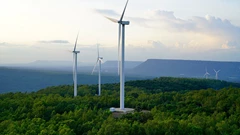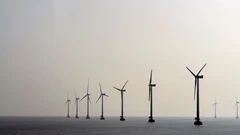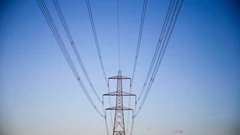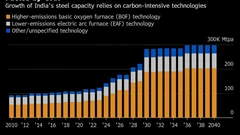China Puts Energy Security First While Doubling Down on Renewables
(Bloomberg) --
Two speeches from China’s top leaders delivered just days apart have provided the most insight yet into the bumpy and contentious path the country will likely take to cut the world’s biggest source of planet-warming emissions.
President Xi Jinping and Premier Li Keqiang painted a portrait of a country that plans to put national security — including from energy shortages — and development first, even as it pursues a green transition. The country will put huge investments into its world-leading renewable energy sector, while also continuing to support polluting fossil fuels that provide the bulk of its energy.
Every economy trying to reach net-zero faces the challenge of maintaining energy security while moving away from dirty fuels, though China is under special pressure to move quickly. It’s the world’s second-biggest economy and largest emitter, and no solution to climate change will work without it. The country still considers itself a developing nation trying to lift more citizens into relative prosperity, the same position countries like the U.K. and U.S. were in a century ago when profligate pollution wasn’t a geopolitical issue.
China’s dilemma has been thrown into sharp focus by a global energy crunch that risks slowing growth and creating social unrest.
That crisis was the topic of a Saturday meeting of several top leaders, where Premier Li delivered his speech. He warned that the nation’s green transition needs to be underpinned by a stable supply of energy and called for an in-depth assessment of the recent power crunch before setting any short-term targets for reaching peak emissions. Production of coal, natural gas and oil are still important to the country’s success and security, he said.
Days later, at a United Nations Biodiversity Conference in Kunming, Xi offered his rejoinder, saying environmental goals have to be both “ambitious” and “pragmatic.” He announced on Tuesday that China had started construction on a giant renewable energy project in the country’s vast deserts that’s bigger than all the wind and solar power in India, as part of its plan to reach net-zero by 2060.
"Short-term boosts of coal and coal-power production don’t necessarily contradict the country's long-term decarbonization goals,” said Beijing-based BloombergNEF analyst Jonathan Luan. “Top leaders' public support for renewables after widespread power cuts at least shows that they believe the growth in clean energy will help energy security."
Still, the energy crisis may constrain China’s ability to make new commitments at high-stakes international climate talks known as COP26 that kick off in Glasgow, Scotland, at the end of the month. A major goal is to agree on a deadline to phase out coal, the dirtiest fossil fuel.
China mines and burns half the world’s supply, and is pushing its producers to boost output to ease power shortages. It has also allowed coal power prices to rise by as much as 20%, double the current limit, a dramatic intervention in a market that China had sought to keep stable in order to ensure predictable costs for industrial users.
Even as governments remain focused on securing coal and gas for the winter, the global energy crisis is in some places accelerating the longer-term transition to cleaner and less volatile sources of power generation. In Spain, authorities have plans to support 3.3 gigawatts of new solar and wind energy. The U.K., one of the countries that’s been hit the hardest by fuel shortages and power disruptions, is aiming to phase out fossil fueled electricity by 2035 by relying in part on nuclear.
China is no exception. Construction has started on the first phase of a project to add 100 gigawatts of solar and wind capacity, Xi said. The news echoed an unconfirmed report that China is planning a 400-gigawatt project in the desert, with half the capacity to be constructed by 2025. A likely location is western China, where existing and planned power lines can link renewables projects to megacities in the east.
“Renewables stand to win” from Chinese policies aimed at easing the electricity crisis, said Tony Fei, an analyst at BOC International Holdings Ltd. “The trend is clear that renewable power generation and consumption will enjoy a premium on government support.”
Saturday's meeting was the fifth time the National Energy Commission has gathered since it was founded in 2010. The group’s mandate is to strategize on issues including energy security. According to a readout, Li emphasized that China’s emission-reduction goals shouldn’t be “rushed,” and arbitrary power cuts should be corrected.
Han Zheng, one of China’s seven most powerful leaders who’s in charge of implementing Xi’s net-zero goal, serves as vice chair. His presence indicates that the road map for cutting emissions would take into account concerns about energy security and the impact of rising energy prices on the public, especially poorer citizens.
That complicates how far China can go to portray itself as a climate leader on the international stage. Xi has sought to leverage cooperation on tackling global warming to counter pushback from the West over everything from trade to the coronavirus and human rights.
"The energy crisis is making a set of major climate moves very complicated," said Li Shuo, a campaigner with Greenpeace. At COP26 and the Group of 20 summit immediately preceding it, China will come under pressure to end domestic coal use. “What's happening at home does not leave a lot of leeway for Chinese negotiators there,” he said.
Growing unhappiness in regions struck by the power crunch — especially in the northeast where residential use has been affected — has pushed the government to shift its short-term priorities, said Qin Yan, an analyst at Refinitiv. But the latest push to boost coal doesn’t go against the nation’s climate plan for 2021 to 2025, where the goal was always to restrict the growth of the fuel’s use, not decrease it.
It does make it less likely that China will move forward its 2030 target for reaching peak emissions, Qin said, something other countries have pressed it to do. China has promised to come to COP26 with more aggressive climate goals, and it’s surprised the international community with unexpected pledges over the last year or so, including its net-zero target and a promise to stop building overseas coal plans.
At the Kunming conference, Xi pledged to establish a biodiversity fund with an initial investment of 1.5 billion yuan ($232 million). Environmentalists expressed disappointment that he didn’t announce more ambitious conservation targets to help member countries work toward goals including to protect 30% of world’s lands and oceans by 2030.
The summit underscored the challenges for COP26 negotiators next month. “Without tangible actions on the table, the world will agree on yet another set of targets with no commitment to delivering them,” said Georgina Chandler, senior policy officer at Britain's Royal Society for the Protection of Birds.
More stories like this are available on bloomberg.com
©2021 Bloomberg L.P.
KEEPING THE ENERGY INDUSTRY CONNECTED
Subscribe to our newsletter and get the best of Energy Connects directly to your inbox each week.
By subscribing, you agree to the processing of your personal data by dmg events as described in the Privacy Policy.
More renewables news

WEC Energy Offered $2.5 Billion US Loan for Renewable Projects

With Trump Looming, Biden’s Green Bank Moves to Close Billions in Deals

GE Vernova Expects More Trouble for Struggling Offshore Wind Industry

Climate Tech Funds See Cash Pile Rise to $86 Billion as Investing Slows

GE Vernova to Power City-Sized Data Centers With Gas as AI Demand Soars

Longi Delays Solar Module Plant in China as Sector Struggles

Australia Picks BP, Neoen Projects in Biggest Renewables Tender

SSE Plans £22 Billion Investment to Bolster Scotland’s Grid

A Booming and Coal-Heavy Steel Sector Risks India’s Green Goals
















